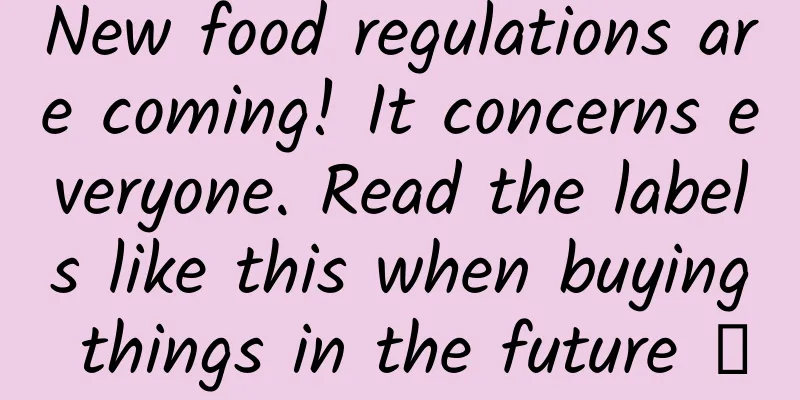New food regulations are coming! It concerns everyone. Read the labels like this when buying things in the future →

|
On March 27, 2025, the National Health Commission and the State Administration for Market Regulation issued 50 national food safety standards and 9 standard amendments. Among them, the "National Food Safety Standard General Rules for Pre-packaged Food Labeling" (GB 7718-2025) and the "General Rules for Nutrition Labeling of Pre-packaged Foods" (GB 28050-2025) are most relevant to our daily diet and life. Today, let's talk about the highlights and the areas that deserve consumers' attention from several angles. "Zero Additive" is prohibited, and labeling is more standardized and convenient Many food companies take advantage of consumers' pursuit of "natural" and dislike of food additives, and use claims such as "no additives" and "zero additives" to attract consumers to buy. But this actually misleads consumers and stigmatizes food additives and the food industry. The new standard clearly stipulates that pre-packaged foods are no longer allowed to use terms such as "no additives" or "zero additives" to place special emphasis on food ingredients; food additives, contaminants, and substances that are not allowed to be added to food or should not be present in food as stipulated in laws, regulations and standards shall not be claimed using words such as "no", "does not contain" and their synonyms. Copyright images in the gallery. Reprinting and using them may lead to copyright disputes. Some friends may wonder why "zero addition" is not acceptable? The main reasons are as follows: First, approved food additives have undergone strict risk assessments, and there is no food safety problem if they are used in compliance with regulations. However, it is impossible for most foods to be completely free of food additives. Finally, the term "zero addition" is easy to avoid the main issue, causing people to ignore the ingredients that really affect health, seriously misleading and interfering with consumer choices. Due to space limitations, I will not expand on this here. In addition to prohibiting the use of misleading terms such as "zero additives" and "no additives", this revision strengthens the quantitative labeling requirements, such as the ingredients or components mentioned in the food name must be marked on the food label. These measures of the new standard are to effectively regulate industry chaos and reduce misleading consumers, so that people will encounter fewer pitfalls when buying things in the future. This revision also introduced digital labels. When you buy food in the future, you can use your mobile phone to scan the QR code on the food packaging to see the food digital label. At the same time, you can learn about the food information through various functions such as page enlargement, voice recognition, video explanation, etc. In this way, you don’t have to worry about the problem of small fonts and unclear reading of food labels, especially for the elderly. The shelf life label is more intuitive When buying food, people are used to looking at the expiration date, but often the packaging only has the production date written on it. We have to find the expiration date on the label and then calculate it ourselves, which is quite troublesome. The new standard requires that the expiration date of pre-packaged food be directly marked as the expiration date , such as "Expiration date until December 31, 2025", so that the expiration date information is more intuitive and consumers do not have to calculate it themselves. This is clearer and simpler than the previous method of production date + shelf life, and it is also more convenient for people to intuitively judge the edible period of food. At the same time, it is stipulated that food with a shelf life of more than 6 months does not need to be marked with the production date, but only with the shelf life and expiration date of the food. In addition, the new standard also stipulates that food producers can voluntarily indicate the "consumption shelf life" of pre-packaged foods based on food properties and edible characteristics for consumers' reference. So, what is the difference between this "shelf life" and "shelf life"? It turns out that the shelf life is the best consumption period for quality, while the shelf life is the last date of consumption of the food. In simple terms, "it is not delicious after the shelf life, and it cannot be eaten after the shelf life." In the future, everyone can judge the last date of consumption of food based on the "consumption shelf life". However, we would also like to remind everyone that food must be stored in accordance with the storage conditions indicated on the label. Improper storage will shorten the shelf life of food and affect food safety and quality. More considerate of special groups Some people have special needs for food, and many of the revisions this time also take these consumers into consideration. First, the mandatory labeling of the eight major allergens in food has been added. The new standard requires that when pre-packaged foods use gluten-containing grains, crustaceans, fish, eggs, peanuts, soybeans, milk, nuts and their products as food ingredients, the allergens contained in the food must be highlighted in the ingredient list by bolding, underlining, or by using allergen reminders below the ingredient list. People with a history of food allergies can pay special attention to the reminder information of allergens on food labels in the future. However, we also need to remind everyone that some products are now promoting the concept of "allergy-free food". However, this standard only clarifies these 8 allergenic foods. Some "allergy-free foods" now only mean that there are no allergens. However, there may still be other allergens that cause allergies in other people, so don't think that you won't be allergic after eating so-called "allergy-free food". In fact, absolute "allergy-free" does not exist, because there are many types of allergens, and everyone's allergic reactions vary from person to person. At present, there is no clear definition of "allergy-free food" worldwide. In addition to the content on allergies, the revised General Rules for Special Medical Purpose Infant Formula also added 6 product categories, including ketogenic formula, anti-reflux formula, and abnormal fat metabolism formula, to serve infants with special needs. It also covers some infants with rare diseases, reflecting care for special groups of people. Mandatory nutrition labeling is more comprehensive The mandatory nutrient labeling has been expanded from "1+4", namely energy and protein, fat, carbohydrates, and sodium, to "1+6", adding saturated fat (acid) and sugar. At the same time, the label "Children and adolescents should avoid excessive intake of salt, oil, and sugar" has been added. Copyright images in the gallery. Reprinting and using them may lead to copyright disputes. Excessive intake of saturated fat is not good for cardiovascular health. However, our survey shows that Chinese residents still have a vague understanding of saturated fatty acids and their relationship with health. Nearly 70% of people do not know that excessive intake of saturated fatty acids is not good for health, which is far from the understanding of the professional community. The labeling requirements added to the standard this time are also to better help everyone implement the "three reductions" healthy lifestyle of reducing salt, oil, and sugar , and reduce the incidence of obesity, cardiovascular and cerebrovascular diseases, diabetes and other diseases. The release of the new standard is good news for the food industry and consumers. I believe it will provide more scientific guidance for the development of the food industry and consumers' diet. For the future, it is recommended to pay attention to two points: · Food companies should standardize their publicity and stop being "smart" in marketing. Judging from the latest standard update, the standardized development of food labels is an inevitable trend. The country is also trying to eliminate some misleading publicity from the root by improving the standards. Strict national food safety standards will also force food manufacturers to standardize production, improve product quality, and reduce false publicity and unfair competition. As consumers, we should spend a little time learning to read labels. The release of new standards is only the first step. The key is whether consumers can really read labels and choose food. In the future, everyone should take the initiative to learn food label information and learn to identify the true attributes of food, so as to choose food more scientifically and independently, improve food safety awareness and health literacy, and develop healthy eating habits. Planning and production Author: Ruan Guangfeng, Deputy Director of Kexin Food and Health Information Exchange Center Review丨Zhang Yu, researcher/PhD, Chinese Center for Disease Control and Prevention, national health science expert Planning丨Lin Lin Editor: Ding Zong Proofread by Xu Lai |
<<: Snail: Those around me who don’t live long are all too impatient.
Recommend
WeChat doesn’t need more lapdogs who only know how to praise
On December 19, some WeChat public accounts allow...
What gift should I give on Valentine’s Day in 2020? When is Chinese Valentine's Day in 2020?
The beginning of autumn passed quickly, and it is...
Chengdu boutique studio is praised by everyone who has been there
Appointment arrangements for Chengdu boutique stu...
How to do Baidu drop-down box promotion, how to brush Baidu drop-down box keywords?
Every webmaster and client who likes SEO wants to...
Two contradictory viewpoints in the same research field won the Nobel Prize in Physiology at the same time
The Nobel Prize ceremony in 1906 was a lively and...
Copywriting methodology: 1 theme, 3 routines, 5 types and 4 psychological cognitions
Sometimes I wonder what the essence of copywritin...
If we knew a hundred years in advance that a giant planet was going to hit the Earth, could humans survive?
An International Planetary Defense Conference is ...
App Promotion: How to Take App Screenshots to Influence Download Conversion Rate?
App screenshots are the most direct way to showca...
Android digital jumping TextView implementation
[[189084]] Introduction DancingNumberView is a co...
Learn about the eCPM calculation formula of information flow advertising in one article
Smart bidding is the most important customer acqu...
Eating the wrong snacks may harm your health! If you are hungry, why not eat these...
Expert in this article: Wang Silu, National Senio...
How to achieve a breakthrough from 0 to 1 in information flow advertising
If you don’t want to be blamed for “ineffective m...
The unity of aging and evolution: Why do lifespans vary so much across species?
We can understand aging from an evolutionary pers...









